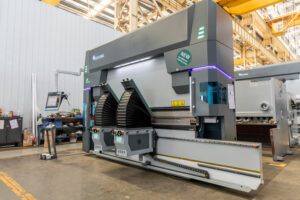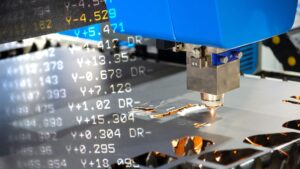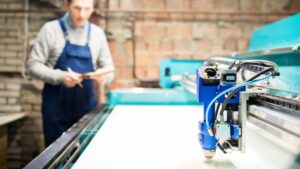Press brakes have so many applications that every day you go through several products that have been directly or indirectly made using this equipment. The extensive press brake applications are one of the main reasons that these machines find use in almost every industrial sector. This article will have an in-depth discussion on the various applications of press brakes in different industries.
What is a Press Brake?
A press brake is a type of industrial machine used for bending sheet metal with force exerted by a heavy punch. The metal sheet is kept on a hollow tool called the die. These machines are very versatile regarding the size of the sheet metal and the angle of the bend. There are many different ways to generate the force required for bending sheet metal. This results in many different kinds of press brakes, such as:
- Mechanical press brakes
- Hydraulic press brakes
- Electric press brakes
- CNC press brakes
- Pneumatic press brakes
What are the Applications of Press Brakes?
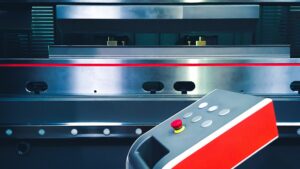
Here are some of the several applications of press brakes organized by the nature of industries:
Metal Fabrication
A press brake is one of the most common types of equipment in metal fabrication workshops. Press brake applications in metal fabrication include:
- Press brakes bend sheet metal for custom fabrication jobs required for turning sheet metal into different designs and shapes. In the metal fabrication industries, press brakes work on various metals such as aluminum, steel, copper, nickel, and more.
Automotive Industry
The automotive industries use press brakes for making parts of all types of vehicles. Some of these parts are:
- Brackets
- Chassis
- Frame components
- Structural parts
- Exhaust systems
- Body part design
- Metal sheet parts for windows and doors
- Parts for very large vehicles like trucks are made with tandem press brakes
Aerospace and Aviation Industry
Aerospace industry uses parts that have extreme physical characteristics and large sizes. Press brakes turn out to be the ideal solution to craft these parts. Some of these parts are:
- Enclosures for engines and other critical components
- Brackets
- Parts for wing assembly
- Parts for landing gear assembly
- Body frames of aircraft and space vehicles
- Production of interior components for aircraft cabins
- Bending sheet metal alloys for high-strength parts of space vehicles
Agriculture Equipment
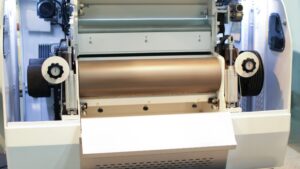
Press brakes are very useful in making parts for agricultural equipment and vehicles. Some of these parts are:
- Brackets
- Agricultural vehicle frames
- Supports
- Structural components
Electrical Equipment
The application of press brakes for electrical parts is mainly to design housing and protection equipment. The sheet metal first goes through a shearing machine that creates the required lengths. The press brake then folds the sheet metal to the right angle. Some examples of parts made are:
- Electrical enclosures for industrial machines
- Control cabinets
- Panels for housing switchgear
- Junction boxes
HVAC Systems
Heating, Ventilation, and Air Conditioning (HVAC) systems use press brakes for applications like:
- Shells for air conditioning
- Air handling units
- Parts for making ventilation systems
- Sheet metal ductwork
Furniture Industry
The furniture industry uses press brakes for a variety of tasks, such as:
Making frames for furniture.
- Bending structural components for outdoor furniture
- Brackets
- Legs
- Support
- Components for wood working machines
- Cabinets and mounting parts
Electronics Appliances
Press brakes make crucial components for several home electronic appliances. Some of these are:
- Refrigerator parts
- Enclosures in washing machines
- Dishwasher parts
- Oven enclosure
Construction

Mechanical press brakes are common for high-strength parts in construction and architecture. Some of these parts are:
- Panels and sheets for roofing
- Tile cladding
- Metal decorations
- Frames for doors and windows
- Bending structural metal sheet for beams and pillars
- Manufacturing metal staircases
- Making structural components like reinforcement bars
- Crafting brackets for mounting doors
Medical Industry
Many products in the medical sector require parts bent by press brakes. Some of these applications are:
- Frames for large equipment
- Mounting brackets
- Hospital beds and stretchers
- Surgical tools
- Diagnostic machines
Oil and Energy Sector
Oil and energy industries use very heavy duty equipment. These machines and machine tooling are difficult to manufacture with traditional processes. Press brakes bend these parts with ease due to their high tonnage. Some of these applications are:
- Drilling machine parts
- Storage tanks for oil
- Tanks and parts for pressure vessels
- Safety device parts such as barriers
- Parts for the mining equipment
- Lamp poles and power poles for connecting electricity are made using press brake machines
Advertising
Press brakes are used in the advertising sector where there is use of metal sheets. Some examples are:
- Letters and logos for metal sheet signage
- Decorative elements such as frames and borders for outdoor and indoor advertising and signage
Railways
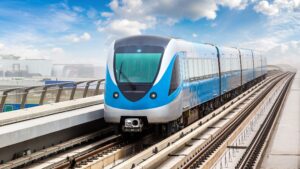
The railways sector extensively relies on press brakes due to the heavy use of metal sheet. Generally, a mechanical press brake is used due to the high tonnage of the required parts. Some applications of press brakes in railways are:
- Parts for train locomotives
- Railings
- Structural parts for trains
- Frames for train carriages
Electronics Telecommunication
Press brakes create many parts for the telecommunication sector. Some of these are:
- Enclosures for communication boxes
- Brackets for mounting telecommunication devices
- Infrastructure for laying network cables
- Communication systems
- Server design
Kitchen Equipment
Many parts of commercial and residential kitchens use press brakes. Some of these are:
- Kitchen Countertops
- Metal shelves and cabinets
- Catering equipment like trays and serving
- Machine in food processing and manufacturing facilities
- Machines and equipment used in restaurants
Art and Aesthetics
Artists use press brakes for bending metal to make art installations. Various designs of curved and bent metal sheets are made using press brake machines.
Defence Industry
Defence and military industries utilize mechanical press brakes for bending high strength metal sheet and alloys. The various parts made by these machines are:
- Containers for storing ammunition
- Defense vehicles
- Armored vehicles
- Armor plates
- Many types of arms
Rubber and Plastics
Many different types of press brakes are used for making molds in the rubber and plastics manufacturing sector. The machines used in manufacturing plastic products also require metal parts made with press brakes.
Chemical Industry
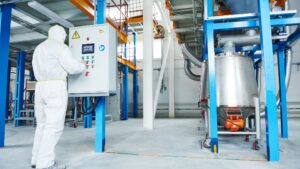
The chemical industry uses many different types of press brakes for bending plate metal in various applications. Some of these applications are:
- Manufacturing storage tanks and large metal containers
- Making large diameter pipes for transferring chemicals and plumbing
- Manufacturing and installing ventilation systems
Plumbing
Press brake applications in the plumbing sector includes:
- Manufacturing of pipes and ductwork
- Mounting brackets for sanitaryware
- Metal supports
Are there specific industries or sectors where press brakes are extensively used?
There are indeed certain sectors that heavily rely on the use of a press brake. These sectors require precision sheet metal parts bent at a certain angle. The most common users of press brakes are:
- Automotive Industry: The automotive industry heavily relies on the press brake due to the high amount of metal parts in every type of vehicle. A press brake is a scalable solution for the automobile sector. It makes everything from small parts like brackets where doors are mounted to large exhaust systems and frame panels.
- Manufacturing Sector: Manufacturing sector uses different types of press brakes for making parts of the production line. Press brakes also make components for production machines. Additionally, protection enclosures for manufacturing equipment are made with press brakes.
- Marine Industry: Press brakes are ideal for making large scale parts for ships and other marine vehicles. Panels for hull and deck are made using the press brake bending process. Tandem press brakes can bend sheet metal for tens of feet of length. This makes the press brake an indispensable machinery in shipbuilding.
What are the Limitations of a Press Brake?

A press brake is an exceptional option for bending sheet metal. However, there can be certain limitations to the process, such as:
- Material Limitations: Press brakes can bend metals and alloys with ease. However, they cannot bend other types of materials.
- Complex Bends: Press brakes often struggle to create complex and multiple bends. Certain complex bends may require intricate press brake tooling.
- Tight Tolerance: Press brakes have limitations when making precise bends. Metal plates curved with the press brake bending process tend to spring back, reducing the precision.
- Bending Thickness: The press brake is limited in terms of the thickness of the metal plate it can bend. Metals with very low thickness can break during the bending process. Thicker materials require a press brake with a high tonnage, such as mechanical press brakes. Options like hydraulic press brakes are limited in terms of tonnage capacity.
- Material Size: The length and width of the work metal is limited to the size of the press brake table. Bigger materials will require a bigger press brake.
What are the Factors to Consider When Choosing a Press Brake For a Particular Application?
Deciding between the different types of press brakes can be confusing. You can use the factors stated below to choose between the different press brakes based on the application:
- Bending Capacity: The bending capacity of a press brake is referred to as tonnage. Mechanical press brakes offer many times more tonnage than their rated capacity. Pneumatic and hydraulic press brakes are not very capable in terms of tonnage. Therefore, for high bending capability, choose a mechanical press brake.
- Precision: While mechanical press brakes offer high tonnage capability, they don’t have high precision. Hydraulic press brakes and servo motor press brakes provide precise bends due to the feature of multiple stops. CNC hydraulic press brakes are a great choice if precision is the primary criteria.
- Bending Length: The bending length depends on the supported table area of the machine. Bending extreme lengths of sheet metal require CNC press brakes with tandem working capability.
- Compatible Material: A press brake is limited to bending plate metal and sheet metal. However, certain metals are harder to bend than others. Opt for a high tonnage mechanical press brake if you intend to bend tough materials.
- Tooling Options: Intricate press brake tooling options are needed when multiple bend angles or complex parts are required.
- Automation: A CNC press brake can provide an automation feature that creates fast bends without much human labor. The press brake operator can oversee the machine operation.
- Safety Feature: Press brake has the capacity to bend metals. Therefore, it can be a safety hazard for the workforce. The press brake you choose should have safeguards such as guard railings and light curtains.
- Production Volume: High-volume production requires CNC press brake technology. Modern CNC press brakes can undertake most bending steps without human labor assistance. A CNC press brake can be integrated with a shearing machine for a completely automated process.
- Space Requirement: Many users buy a press brake without measuring their workshop’s available area. This creates problems later on during machine installation and usage. Therefore, carefully measure the available area of the workshop and add an extra margin for clearance. This value can provide the maximum size of the press brake you can install in your current setup.
Are Press Brakes a Scalable Solution?
Yes, press brakes are a very scalable machine. It can be used for large-scale production and small-scale operations alike. The machine’s capability can be chosen based on the requirement of the operation.
For instance, the use of a press brake for a large number of parts requires CNC technology features. CNC hydraulic press brakes are also a good fit for the small-scale bending of sheet metals. These machines have a high precision that is well-suited for custom jobs.
Emerging Trends in Press Brake Technology
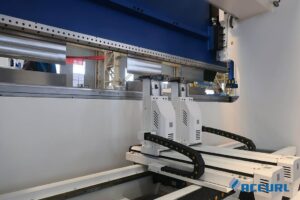
The future of press brake technology is advancing toward automated control. Modern machines such as press brakes can completely integrate into the assembly line. The operator can control press brake machines remotely. Additionally, the precision of the press brake is also an area that is seeing tremendous improvement. This is why press brakes are replacing alternative metal bending machines in most sectors.
Endnotes
Press brake machines are the most sought after option for sheet metal bending. There are vast applications for every type of press brake due to the several benefits of these machines. The different types of press brakes bring varying utilities to the end users.
For instance, mechanical press brakes are great for bending materials with extreme toughness.
A hydraulic press brake is a good fit for making precise and accurate bends. If you are thinking about getting a machine to bend sheet metals, press brakes can be the perfect fit for you.


